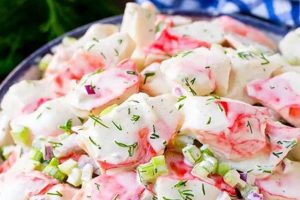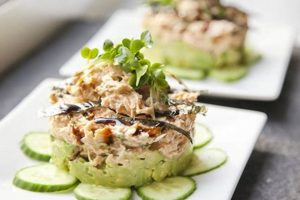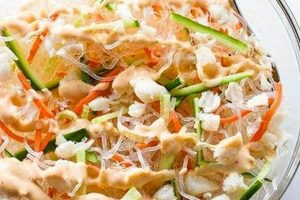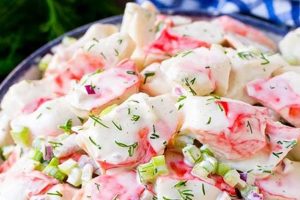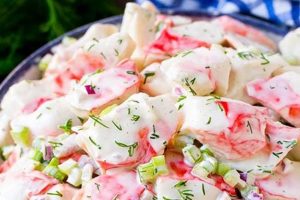A preparation method for a popular sushi filling involves combining imitation crab meat (surimi) with mayonnaise, seasonings, and often other ingredients like vegetables. Variations exist, ranging from simple mixtures to more complex versions incorporating ingredients such as masago (capelin roe), sriracha, or sesame oil. This mixture is typically used as a filling for maki rolls (hosomaki, uramaki, futomaki) or other sushi preparations like gunkan maki.
This filling offers a cost-effective and readily available alternative to fresh crab meat. Its mild flavor profile and creamy texture make it palatable to a wide range of consumers, contributing to its popularity in sushi restaurants and home kitchens. The convenience of pre-packaged imitation crab simplifies the preparation process, making it an accessible option for novice sushi makers. Furthermore, the versatility of the filling allows for creative adaptations with diverse flavor combinations to suit individual preferences.
The following sections will explore specific ingredient selections, step-by-step preparation instructions, recommended sushi roll pairings, and techniques for achieving optimal flavor and texture.
Tips for Crafting Exceptional Crab Salad for Sushi
Optimizing a crab salad recipe requires attention to detail and an understanding of balancing flavors and textures. These tips offer guidance for achieving superior results.
Tip 1: Quality Surimi Selection: Opt for high-quality imitation crab meat with a firm texture and a fresh, slightly sweet flavor. Avoid products with an overly fishy odor or a mushy consistency.
Tip 2: Mayonnaise Matters: Japanese mayonnaise is recommended for its richer, slightly sweeter flavor profile compared to standard Western mayonnaise. Adjust the quantity to achieve the desired creaminess without making the mixture overly wet.
Tip 3: Seasoning Subtleties: Rice vinegar enhances the flavor profile and complements the other ingredients. A touch of sesame oil adds richness, while a pinch of sugar balances the acidity. Experiment with sriracha or other chili sauces for a spicy kick.
Tip 4: Textural Enhancements: Finely diced cucumbers or carrots add a refreshing crunch and visual appeal. Masago (capelin roe) introduces a briny pop and subtle fish flavor.
Tip 5: Chilling Time: Allowing the prepared crab salad to chill in the refrigerator for at least 30 minutes allows the flavors to meld and enhances the overall taste experience. This also firms the mixture, making it easier to handle when assembling sushi rolls.
Tip 6: Mindful Mixing: Combine ingredients gently to avoid breaking down the surimi and creating a mushy texture. A light touch ensures a pleasant mouthfeel.
Tip 7: Portion Control: Avoid overfilling sushi rolls, as this can make them difficult to roll and may compromise the structural integrity of the finished product.
By adhering to these guidelines, one can create a crab salad filling that elevates sushi rolls to a new level of culinary enjoyment. The careful selection of ingredients and attention to preparation techniques will yield a flavorful and visually appealing final product.
These techniques and considerations provide a strong foundation for creating delectable sushi. The subsequent conclusion will summarize key points and offer final recommendations.
1. High-quality imitation crab
Imitation crab, or surimi, plays a crucial role in crab salad intended for sushi. The quality of this ingredient significantly impacts the final flavor, texture, and overall appeal of the dish. Selecting high-quality imitation crab is essential for a successful sushi experience.
- Texture and Firmness
High-quality surimi exhibits a firm, slightly springy texture that holds its shape well when mixed with other ingredients. This characteristic prevents the salad from becoming mushy and ensures a pleasant mouthfeel when incorporated into sushi rolls. Lower quality alternatives often have a softer, more fragmented texture that detracts from the overall presentation and eating experience.
- Flavor Profile
Superior imitation crab possesses a delicate, subtly sweet flavor reminiscent of real crab. It lacks the strong fishy odor or taste often associated with lower-grade products. This mild flavor profile allows the other ingredients in the salad, such as mayonnaise and seasonings, to shine through without being overpowered. A balanced flavor profile is key to achieving a harmonious crab salad filling.
- Color and Appearance
High-quality surimi typically displays a consistent, bright white color with a slight reddish or pinkish hue on the outer edges, mimicking the appearance of cooked crab meat. This visual appeal enhances the presentation of the finished sushi rolls. Dull or uneven coloring can indicate lower quality and may negatively impact the aesthetic appeal of the dish.
- Ingredient Composition
Premium imitation crab is made from a higher percentage of Alaskan Pollock or other white fish, resulting in a superior taste and texture. The ingredient list should be relatively short and free of excessive fillers or artificial additives. A cleaner ingredient list typically translates to a higher quality product.
By prioritizing these qualities when selecting imitation crab, one ensures a crab salad filling that complements the other sushi components and delivers a satisfying culinary experience. The quality of the surimi significantly impacts the final product, highlighting the importance of choosing wisely.
2. Japanese Mayonnaise
Japanese mayonnaise constitutes a crucial element in crab salad specifically designed for sushi, differentiating it significantly from its Western counterpart. This distinction arises from several key characteristics that influence the overall flavor profile and texture of the salad. The emulsifying properties of Japanese mayonnaise, derived from its unique blend of ingredients, contribute to a richer, creamier consistency compared to Western mayonnaise. This richness enhances the mouthfeel of the crab salad and contributes to a more luxurious sushi experience. Furthermore, the flavor profile of Japanese mayonnaise, characterized by a subtle sweetness and umami depth due to the inclusion of ingredients like rice vinegar and MSG, complements the delicate flavor of imitation crab meat, creating a harmonious balance. Western mayonnaise, with its tangier profile and less pronounced umami notes, can overpower the subtle flavors of the surimi.
Authentic Japanese sushi restaurants invariably utilize Japanese mayonnaise in their crab salad preparations, highlighting its importance in achieving the desired flavor profile. The creamy texture of Japanese mayonnaise also binds the other ingredients effectively, such as shredded imitation crab, vegetables, and seasonings, creating a cohesive filling that holds its shape within the sushi roll. Attempting to substitute Western mayonnaise often results in a looser mixture that lacks the desired richness and can compromise the structural integrity of the roll. For instance, a California roll made with Western mayonnaise will typically exhibit a less creamy, slightly tangier filling that deviates from the expected flavor profile.
Understanding the role of Japanese mayonnaise proves essential for replicating authentic sushi flavors. The distinct properties of this ingredient contribute significantly to the overall taste and texture of crab salad, ultimately influencing the success of the final sushi preparation. The creamy richness, subtle sweetness, and umami depth provided by Japanese mayonnaise are integral to a well-balanced and flavorful crab salad filling. Substituting with alternative mayonnaises can lead to noticeable differences in both taste and consistency, potentially compromising the intended culinary experience.
3. Seasoning Balance
Seasoning balance represents a critical factor in a successful crab salad recipe for sushi. The delicate flavor of imitation crab meat necessitates careful consideration of complementary flavors and a judicious approach to seasoning. Achieving harmony among the various components ensures a palatable and enjoyable final product.
- Acidity
Rice vinegar contributes a necessary acidic element, balancing the richness of the mayonnaise and enhancing the overall flavor profile. The acidity brightens the other flavors without overpowering the delicate taste of the crab. Too much vinegar can create an overly sharp taste, while too little can result in a bland salad. The appropriate level of acidity enhances the other ingredients and contributes to a more refreshing final product.
- Saltiness
Salt enhances the inherent flavors of the ingredients and provides a savory depth. However, excessive salt can easily overpower the subtle flavor of the imitation crab. A light hand with salt is recommended, allowing the other seasonings to contribute to the overall flavor profile. Sea salt or kosher salt is generally preferred for its clean flavor.
- Sweetness
A touch of sugar balances the acidity of the rice vinegar and complements the natural sweetness of the imitation crab. This subtle sweetness rounds out the flavor profile and prevents the salad from tasting overly sharp. Granulated sugar or mirin can be used to achieve the desired level of sweetness. The amount of sugar should be carefully measured to avoid an overly sweet result.
- Umami
A small amount of sesame oil adds a subtle nutty flavor and enhances the umami notes of the dish. This richness complements the other ingredients without overpowering the delicate flavor of the crab. Other sources of umami, such as a dash of soy sauce or a pinch of MSG, can also be used sparingly to enhance the savory depth of the salad.
The interplay of these seasonings creates a balanced and flavorful crab salad filling that complements the other sushi components. Achieving the proper balance is essential for a harmonious flavor profile, ensuring that no single element dominates the overall taste experience. Over-seasoning can mask the delicate flavor of the imitation crab, while under-seasoning can result in a bland and unappealing dish. Careful consideration of these elements is crucial for a successful and enjoyable sushi preparation.
4. Textural Additions
Textural additions play a vital role in enhancing the sensory experience of crab salad intended for sushi. The inherent softness of imitation crab meat and the creaminess of mayonnaise benefit from contrasting textures, creating a more dynamic and enjoyable mouthfeel. These additions introduce complexity and prevent the salad from feeling monotonous. Several ingredients serve this purpose effectively.
Finely diced vegetables, such as cucumbers, carrots, or water chestnuts, offer a crisp, refreshing counterpoint to the softer elements of the salad. Their subtle flavors also complement the mild taste of the crab. The small size of the dice ensures even distribution throughout the salad and prevents any single piece from overpowering the other ingredients. Similarly, incorporating tobiko (flying fish roe) or masago (capelin roe) introduces a briny pop and a slight crunch. These small, flavorful eggs burst in the mouth, adding a textural dimension and a subtle seafood essence that complements the imitation crab. Tempura flakes, though less traditional, provide a light, airy crispness that contrasts with the creamy and soft textures. Their delicate flavor does not overpower the other components.
Careful consideration of textural variety elevates crab salad from a simple mixture to a more sophisticated filling. The interplay of soft, creamy, and crisp elements creates a balanced sensory experience. Ignoring this aspect can result in a one-dimensional texture that lacks interest. The choice of textural additions depends on personal preference and the desired overall effect. However, the goal remains consistent: to introduce contrasting textures that enhance the enjoyment of the sushi.
5. Proper Chilling
Proper chilling plays a crucial role in optimizing the quality and safety of crab salad intended for sushi. Chilling impacts several key characteristics, including flavor development, texture, and food safety. The process allows the flavors of the various ingredientsimitation crab meat, mayonnaise, seasonings, and any textural additionsto meld and harmonize, resulting in a more complex and balanced flavor profile. Without sufficient chilling time, the individual flavors may remain distinct and less integrated.
Furthermore, chilling firms the texture of the crab salad, making it easier to handle during the sushi assembly process. A chilled salad is less likely to become watery or spread excessively when placed onto nori or rice, ensuring a neater and more structurally sound sushi roll. This firmness also contributes to a more pleasant mouthfeel, enhancing the overall dining experience. Attempting to work with a warm or room-temperature crab salad can result in a messy assembly process and a less appealing final product.
From a food safety perspective, proper chilling is paramount. Mayonnaise-based salads are susceptible to bacterial growth at room temperature. Chilling inhibits bacterial proliferation and minimizes the risk of foodborne illness. Adhering to safe food handling practices, including maintaining a refrigerator temperature of 40F (4C) or below, is essential when preparing and storing crab salad. Consuming improperly chilled crab salad can pose significant health risks. Therefore, proper chilling is not merely a culinary recommendation but a critical food safety precaution.
Frequently Asked Questions
This section addresses common inquiries regarding crab salad preparation for sushi, offering clarity and guidance for optimal results.
Question 1: What type of imitation crab meat is best suited for sushi?
High-quality surimi, preferably made with a significant percentage of Alaskan Pollock, offers the best flavor and texture. Look for firm, white meat with a slightly sweet flavor and avoid products with a strong fishy odor or mushy consistency. The quality of the surimi significantly impacts the final taste and texture of the crab salad.
Question 2: Can regular mayonnaise be substituted for Japanese mayonnaise?
While substitution is possible, it’s not recommended. Japanese mayonnaise possesses a distinct flavor profilericher, sweeter, and with more umamithat complements the delicate flavor of imitation crab. Regular mayonnaise can overpower the subtle crab flavor and result in a less authentic taste.
Question 3: How long should crab salad be chilled before using it in sushi?
Chilling for at least 30 minutes allows the flavors to meld and the mixture to firm up, making it easier to handle during sushi assembly. From a food safety perspective, thorough chilling is crucial for inhibiting bacterial growth in mayonnaise-based salads.
Question 4: What are some suitable textural additions for crab salad in sushi?
Finely diced cucumbers or carrots offer a refreshing crunch. Masago (capelin roe) provides a briny pop, while tempura flakes introduce a light, airy crispness. These additions enhance the sensory experience by contrasting with the soft textures of the crab and mayonnaise.
Question 5: How can one prevent crab salad from becoming too watery?
Using high-quality surimi and ensuring adequate chilling time helps maintain a firmer consistency. Avoid overmixing, which can break down the crab meat and release excess moisture. Draining any excess liquid from the diced vegetables before incorporating them into the salad also helps prevent a watery consistency.
Question 6: Is it safe to use leftover crab salad for sushi?
Leftover crab salad should be refrigerated promptly and consumed within 24 hours. Ensure the salad has been consistently chilled at 40F (4C) or below to minimize the risk of bacterial growth. Exercise caution and discard any salad that exhibits signs of spoilage, such as an off odor or discoloration.
Understanding these aspects of crab salad preparation contributes significantly to a successful and enjoyable sushi-making experience. Careful attention to ingredient selection, chilling times, and flavor balance ensures optimal results.
This concludes the frequently asked questions section. The following section will offer a complete recipe and step-by-step instructions for preparing crab salad for sushi.
Crab Salad Recipe for Sushi
This exploration of crab salad recipes for sushi has highlighted the critical components contributing to a successful preparation. From the selection of high-quality surimi to the delicate balance of seasonings, each element plays a vital role in the final outcome. Proper chilling techniques are essential not only for flavor development and optimal texture but also for ensuring food safety. The incorporation of textural elements elevates the sensory experience, adding complexity and interest to the overall dish. Understanding the distinct properties of Japanese mayonnaise and its importance in achieving authentic flavor profiles is crucial for culinary success.
Ultimately, crafting exceptional crab salad for sushi requires attention to detail and a commitment to quality ingredients. Careful consideration of these factors ensures a rewarding culinary experience, transforming simple ingredients into a delectable and satisfying component of Japanese cuisine. This knowledge empowers both novice and experienced cooks to create sushi that is both delicious and aesthetically pleasing, demonstrating the potential for culinary artistry within even the simplest of dishes. Further exploration of regional variations and innovative flavor combinations promises to enrich the culinary landscape of sushi preparation.

